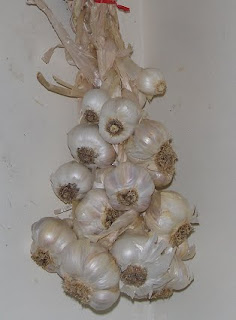Observations, and such
Notes On the Kitchen Calendar
Saturday, December 01, 2012
Rum, Ruin, Rumination & Resolutions
It has been a little over two years since the last post. Busy I guess. (Grin.) At the moment the garden is in disrepair as the last of the summer crops are still pushing out a few fruits. Lemon tree is in the weird interregnum where for a few weeks we actually have no ripe lemons to pick. (The rest of the year this tree is in never ending production, with buds on just as the last round comes ripe.) The mandarin oranges are all green, apples are long gone, and we didn't get a winter crop of anything in yet.
I blame the weird weather. And the neighbor spraying roundup.
Too hot too late in the year to think of winter crops in a timely fashion. And the annoyance of finding out your next door neighbor has been spraying the border grass (including the base of the vegetable planter) with Roundup fer cryin; out loud, has severally limited the plantings.
But Winter Break is coming, and perhaps we can get the planting spaces squared away and nourished in time for our February spring plantings . . .
Saturday, July 31, 2010
Four Batches of Homemade Granola Down, And the Recipe for You, Finally
 So, I owe several people the recipe for homemade granola . . . and have been negligent in keeping garden posts up this spring . . . so to hop back into the ol' blog I will start there.
So, I owe several people the recipe for homemade granola . . . and have been negligent in keeping garden posts up this spring . . . so to hop back into the ol' blog I will start there.- Mix dry oats and almonds together in a large bowl; be sure there is room to stir the mixture after adding oil and honey.
- Mix the honey and olive oil with a hand or stand mixer on low, or light whisk. The goal is to evenly distribute the honey and oil so that it will evenly coat the oats.
- Pour a portion of the honey-oil over the oats and stir it in. Add some more honey-oil mixture and stir, to coat the oats and almonds. Continue adding honey-oil and stirring until (a) all the mixture is in and (b) all the oats have been coated. This may require some stirring well after all the honey-oil is added.
NEXT:
Cover a baking sheet (with edges) with parchment paper, or be prepared to scrub after baking. Spoon the oat mixture on the parchment and spread evenly.
Preheat oven to 350 F. Place sheet on middle rack, and bake for 20 minutes. After 20 minutes check cereal color and stir on the sheet. Cereal should be just tan. The final bake time will be between 20 and 30 minutes longer, but check the cereal every 10, then every 5 minutes.
Once the cereal starts browning it can go from lightly brown, to nut brown, to burnt in a few seconds. When the cereal is a light brown remove the cookie sheet from the oven. If the cereal cools on the sheet, it will continue to brown. If the cereal is already brown enough, slide the parchment off the tray and onto a heat-proof surface.
Let the cereal cool until cold, crumble into a bowl. And the cashews add dried fruits, mixing well. Store in sealed kitchen or Mason jars; makes about 3 quarts by volume with these add-ins.
Variations
Nuts: Substitute any nuts that you like, or leave them out entirely. Dry nuts (such as dry- roasted almonds) can go in with the oats, and are great with the honey-oil mixture. Oily nuts, such as cashews, peanuts, or similar, should go in with the dried fruit and not be heated. If nuts are omitted from the oats, reduce the oil slightly, by about a 1/8 to 1/4 cup.
Dried Fruits: Any dried fruits will work. I have used home grown dried apples and figs; my wife prefers no nuts and a mixture of Trader Joe's Raisins and "Golden Berry Blend"
Other Stuff: Leslie also likes to sprinkle ground flax meal on the spread out oats before baking (1/8 to 1/4 cup). Adds some good omega-3's and fiber, and a little nutty flavor. To turn it into candy, add a few chocolate chips. Really, the issues is to add what you like!
Eating: Great as a filling snack (a handful in a wax paper bag goes a long way) or as traditional cereal with milk. Or with vanilla or maple yogurt. Greek style yogurt is interesting too, and you can add fresh fruit for a change from time to time.
** All ingredients are organic or otherwise cleaner versions where feasible. The organic oats are easily available at Wholefoods at modest prices; the other ingredients all come from Trader Joe's, of course.
Monday, February 15, 2010
Spring Planting Redux: Summer's Salads
 Four-day weekend -- with no rain and warmish sunshine -- let us get some things done and finish up the garden layout.
Four-day weekend -- with no rain and warmish sunshine -- let us get some things done and finish up the garden layout. s at around 300 sq. feet, exclusive of of fruit trees and a dozen large pots. When we finish Spencer's patch we will be looking at about 350 sq.feet, a respectable space if I do say so.
s at around 300 sq. feet, exclusive of of fruit trees and a dozen large pots. When we finish Spencer's patch we will be looking at about 350 sq.feet, a respectable space if I do say so.  interplanted with some interesting English (Kew Gardens Brand) organic carrots.
interplanted with some interesting English (Kew Gardens Brand) organic carrots. for fall, and maybe a corner of broccoli.
for fall, and maybe a corner of broccoli. 
Saturday, February 06, 2010
First Pass on Early Spring Planting; Hungry Already! Is it Summer Yet?

Sunday, January 10, 2010
We "Tie One On" Without the Master Craftsman Nearby, and It Comes Out Okay.
 Been working on a new skill for the last several weeks. Back in September, took a
Been working on a new skill for the last several weeks. Back in September, took a broom tying class from Little John, arranged by the folks at Adams Forge. Didn't quite finish the broom we made in class, and needed to find the materials to sew it down. Which proved a but of an odyssey, but worth it in the end.
broom tying class from Little John, arranged by the folks at Adams Forge. Didn't quite finish the broom we made in class, and needed to find the materials to sew it down. Which proved a but of an odyssey, but worth it in the end.Tried making a broom needle out of various objects, but none did the trick. Finally orderd a flat steel "needle" that worked really well.
 Except that it had very sharp edges and a very sharp point and it had a tendency to cut the sewing thread. But what are a blacksmith's tools for if not making and fixing other tools. (Grin.)
Except that it had very sharp edges and a very sharp point and it had a tendency to cut the sewing thread. But what are a blacksmith's tools for if not making and fixing other tools. (Grin.)
It was really fun to do, and the end product looked great, even if it was a mediocre outcome. So I figured I wanted to do it again. But one thing I had learned was that the proper equipment makes a big difference.
 Unfortunately, to properly tie a broom you need to pull on the string pretty hard while turning the handle -- which requires a "tying wheel."
Unfortunately, to properly tie a broom you need to pull on the string pretty hard while turning the handle -- which requires a "tying wheel." saw . . . After a couple of false starts, I cobbled up this tying wheel: Solid oak, and it smells like wine. (Grin.)
saw . . . After a couple of false starts, I cobbled up this tying wheel: Solid oak, and it smells like wine. (Grin.) and really long -- plus broken bits. It took a little while to do as I started out with "long" and "short" and discovered that the straw came in three distinct lengths, not two, so had to restart at one point.
and really long -- plus broken bits. It took a little while to do as I started out with "long" and "short" and discovered that the straw came in three distinct lengths, not two, so had to restart at one point.  expected, and proved that the tying wheel worked.
expected, and proved that the tying wheel worked. At the end, I clamped the broom in the post-leg vise between two more barrel staves to sew it. Came out pretty ok, given all the oopses and redos.

The Holly-Handled First Solo Broom
Saturday, November 14, 2009
Cider, Woodsmoke, Soap Bubbles, Beef, Barley & Guiness Give the Illusion of Fall in SoCal

Sunday, October 18, 2009
Garlic Madness Under the Moontree
 Yes, madness I say. Garlic everywhere, and not a vampire in sight!
Yes, madness I say. Garlic everywhere, and not a vampire in sight!This is, I think, my fifth fall planting garlic. (It all started with some sprouting store-bought stuff several years ago; several garlic related posts here.)
- Chesnok Red a hardneck purple-stripe garlic said to be good for baking;
- Killarney Red another hardneck, a true rocambole;
- Cuban Purple / Rojo de Castro, a delighful hardneck creole that we love in pesto;
- S&H Silverskin, a softneck, braidable, silverskin variety;
- Lorz Italian, a softneck, braidable, artichoke variety
 onion. So, since there where lots of odds and ends (at least 5 cloves of each variety) I planted a patch to pick before the bulbs mature without regret.
onion. So, since there where lots of odds and ends (at least 5 cloves of each variety) I planted a patch to pick before the bulbs mature without regret. Growing garlic also provided the interesting discovery that chopped greens -- just some of the leaf or even the stalk of a pulled green garlic -- make a lovely garlic-flavored chive sort of effect!
 enough garlic in the ground, including one silverskin variety allready.
enough garlic in the ground, including one silverskin variety allready.Now that the bulk of the garlic planting is done, there are always a few cloves extra for the available space, so we will be having a small side by side taste test comparison soon.
Coming Soon: Cider Season!


